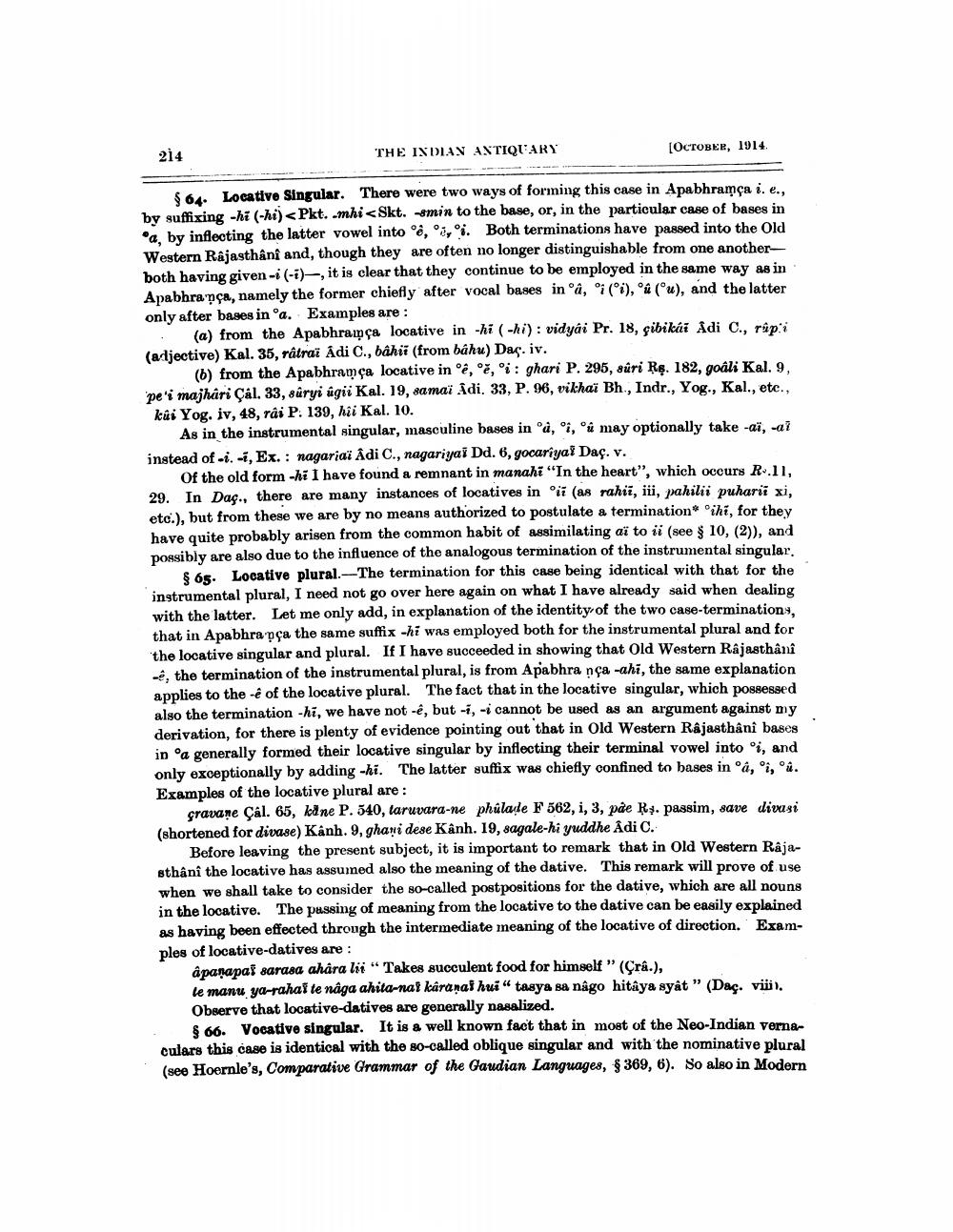________________
214
THE INDIAN ANTIQUARY
§ 64. Locative Singular. There were two ways of forming this case in Apabhramça i. e., by suffixing -hi (-hi) <Pkt. .mhi<Skt. -smin to the base, or, in the particular case of bases in a, by inflecting the latter vowel into è, &,i. Both terminations have passed into the Old Western Rajasthânî and, though they are often no longer distinguishable from one anotherboth having given-i (-i)-, it is clear that they continue to be employed in the same way as in Apabhrança, namely the former chiefly after vocal bases in °â, °i (i), °û (u), and the latter only after bases in °a. Examples are:
(a) from the Apabhrança locative in -hi (hi): vidyai Pr. 18, çibikái Adi C., râpi (adjective) Kal. 35, râtraï Adi C., bâhii (from bahu) Daç. iv.
(b) from the Apabhramça locative in °ê, °, °i: ghari P. 295, sûri Rs. 182, goâli Kal. 9, pe'i majhari Çal. 33, sûryi ügii Kal. 19, samaï Âdi. 33, P. 96, vikhaï Bh., Indr., Yog., Kal., etc., kui Yog. iv, 48, râi P. 139, hii Kal. 10.
As in the instrumental singular, masculine bases in °à, i, û may optionally take -aï, -a? instead of -i. -i, Ex.: nagariai Adi C., nagariyal Dd. 6, gocariyal Daç. v.
Of the old form -hi I have found a remnant in manahi "In the heart", which occurs R.11, 29. In Daç., there are many instances of locatives in ii (as rahii, iii, pahilii puharii xi, etc.), but from these we are by no means authorized to postulate a termination* ihi, for they have quite probably arisen from the common habit of assimilating aï to ii (see § 10, (2)), and possibly are also due to the influence of the analogous termination of the instrumental singular.
§ 65. Locative plural.-The termination for this case being identical with that for the instrumental plural, I need not go over here again on what I have already said when dealing with the latter. Let me only add, in explanation of the identity of the two case-terminations, that in Apabhrança the same suffix -hi was employed both for the instrumental plural and for the locative singular and plural. If I have succeeded in showing that Old Western Rajasthânî -ê, the termination of the instrumental plural, is from Apabhra nça -ahi, the same explanation applies to the -ê of the locative plural. The fact that in the locative singular, which possessed also the termination -hi, we have not -ê, but -i, -i cannot be used as an argument against my derivation, for there is plenty of evidence pointing out that in Old Western Rajasthânî bases in a generally formed their locative singular by inflecting their terminal vowel into 'i, and only exceptionally by adding -hi. The latter suffix was chiefly confined to bases in °â, i, ú Examples of the locative plural are:
°û.
[OCTOBER, 1914.
gravane Çal. 65, käne P. 540, taruvara-ne phûlade F 562, i, 3, pae Rs. passim, save divasi (shortened for divase) Kânh. 9, ghani dese Kânh. 19, sagale-hi yuddhe Adi C.
Before leaving the present subject, it is important to remark that in Old Western Râjasthânî the locative has assumed also the meaning of the dative. This remark will prove of use when we shall take to consider the so-called postpositions for the dative, which are all nouns in the locative. The passing of meaning from the locative to the dative can be easily explained as having been effected through the intermediate meaning of the locative of direction. Examples of locative-datives are:
âpaṇapat sarasa ahâra lii "Takes succulent food for himself " (Crâ.),
le manu ya-raha te naga ahita-nal kâraṇal hui" tasya sa nago hitâya syât" (Daç. viii). Observe that locative-datives are generally nasalized.
§ 66. Vocative singular. It is a well known fact that in most of the Neo-Indian vernaculars this case is identical with the so-called oblique singular and with the nominative plural (see Hoernle's, Comparative Grammar of the Gaudian Languages, § 369, 6). So also in Modern




